Hispanic Heritage Month and Our Spanish Programming

The theme for 2023 is “Latinos: Driving Prosperity, Power, and Progress in America,” highlighting the contributions of Hispanics to the economic, political, and social growth of the United States.
Everyone faces adversity and mental health challenges. Within the Hispanic community 22% of people report mental health challenges. That is a lot of people especially considering mental health challenges are often viewed as a weakness within the community often leading to people less likely to reach out for support. Those who do reach out to support face barriers such as language barriers, therapists who are not culturally competent, and insurance issues.
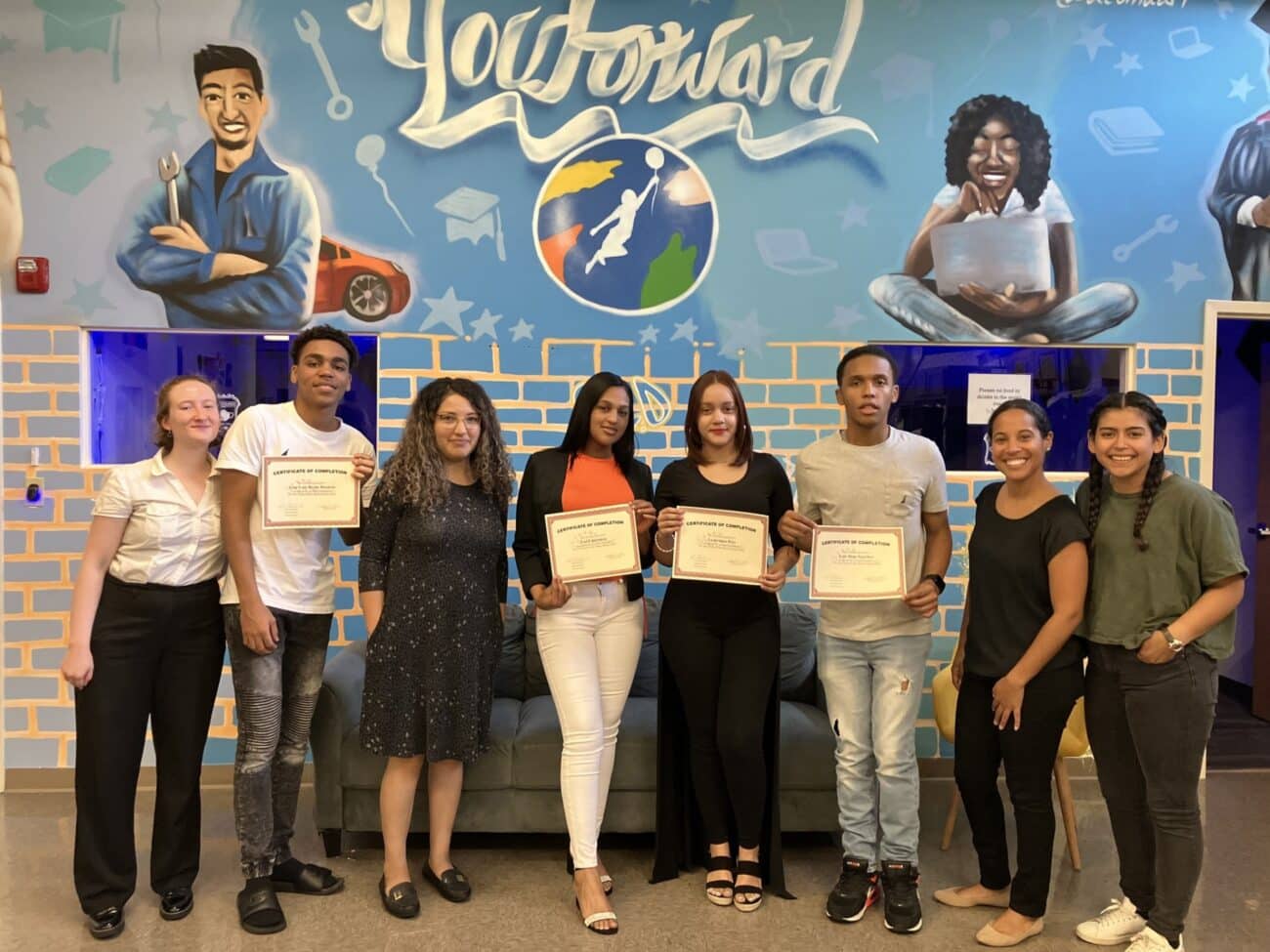
Our Newest Spanish-Speaking Peer Mentors at their Graduation
The NAN Project has recently begun implementing hispanic voices into our mental health programming to combat this stigma. This year we had five Spanish-speaking and two bilingual peer mentors train and graduate to work with The NAN Project and tell their inspiring stories of mental health struggles! We were thrilled to welcome these Spanish speaking peer mentors to our team as they help us to better expand our reach into diverse communities. In October alone, we already have five foreign language presentations lined up! For example, this week at Keverian Middle School in Everett, MA we presented to a class and shared Comeback stories in both Spanish and Portuguese.
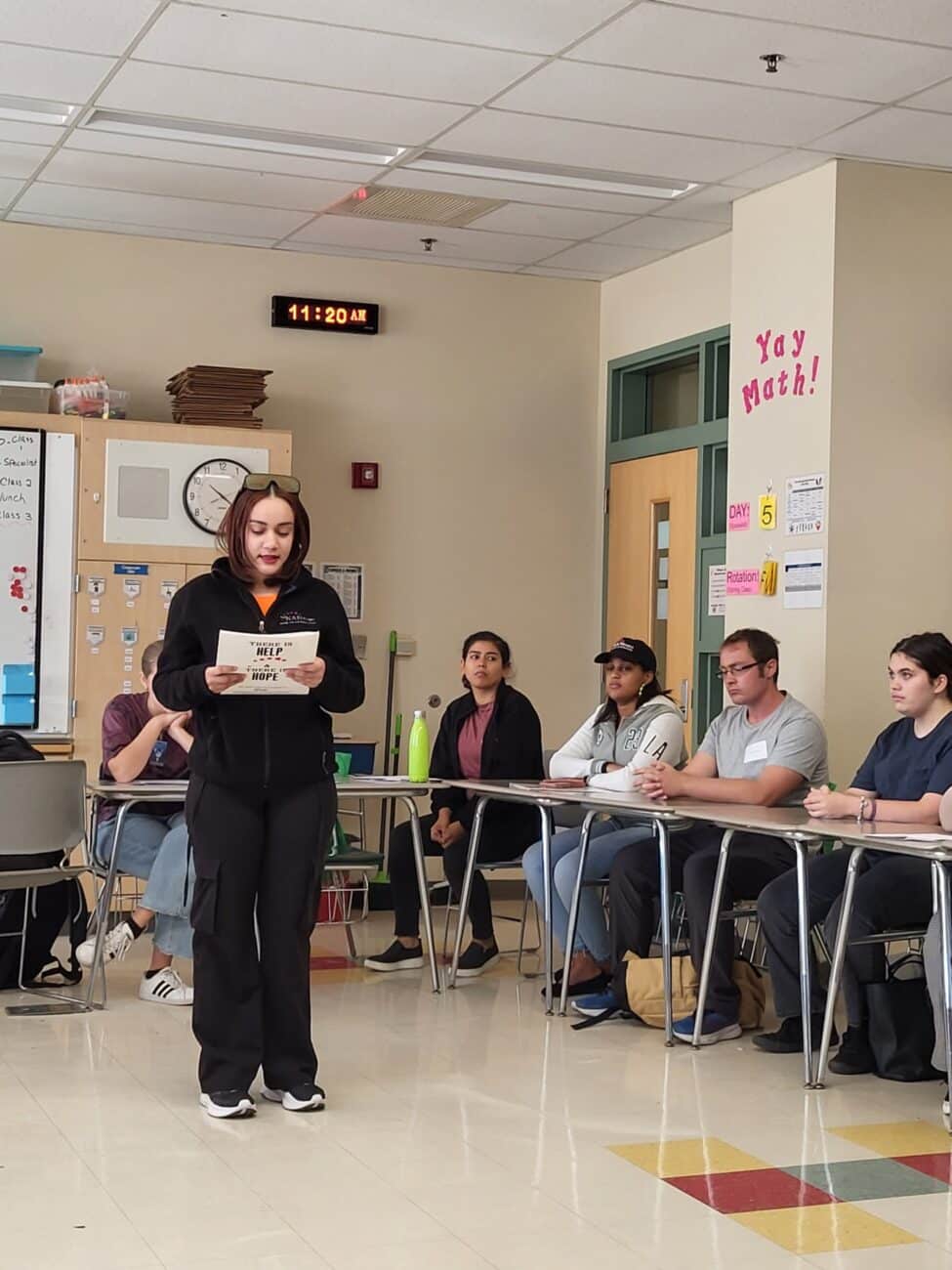
Spanish Language Presentation in Everett, MA
Mental health can be especially stigmatized in hispanic communities, therefore it is extremely important to us that our programming is multiculturally accessible. During our spanish speaking presentations, we have noticed that students connect much more with the topic of mental health when the stories and struggles are told in their native language. We look forward to continuing to build upon our spanish language programming and are excited to offer hispanic youth the chance to explore their feelings and emotions surrounding mental health.
Some Hispanic based mental health supports are:
Hispanic Clinical Services in Lawrence MA
Cass Esperanza in Boston MA
The American Society of Hispanic Psychiatry
Therapy for LatinX
Some of the events coming up locally to celebrate Hispanic Heritage Month are:
Friday Oct. 6, 2023
6-10 pm
Annual Hispanic Heritage Month Celebration Fundraiser
Fri, Oct 6, 7:30 – 8:30 PM
40 Academy Hill Rd, Brighton, MA
For children ages 7-12, they will learn the basics of poetry writing and will share their poems with the group; led by Boston Youth Poet Laureate Alondra Bobadilla
Thu, Oct 26, 9:30 AM – 4:30 PM
Boston Public Library – Central Library
700 Boylston St, Boston, MA
For the month of October, Special Collections will be highlighting items in our collections from Hispanic creators for National Hispanic Heritage Month. Celebrate National Hispanic Heritage Month
Fri, Oct 13, 8 – 10 AM
Union Station Grand Hall
2 Washington Sq, Worcester, MA
Presented by CENTRO Inc., The Institute of Latino Art & Culture invites you to their 4th Annual Central Mass Hispanic Heritage Breakfast
Finding Help

The next step is finding “your people” which is vital for being able to get the help you want or need. That looks different for different people. Sometimes it’s a peer group, family, teachers, mental health professionals, or doctors. The main thing that is important is finding them. A great place to start is in your family, doctors office, and school. Teachers and school counselors are amazing resources to utilize and can open up a ton of other possibilities. A school counselor or primary care doctor can get you linked to resources you might need out of school hours. They can put in referrals to therapists, peer mentors, support groups, and they can help you have discussions with your family on accessing these things.
A lot of students really worry about how they are going to financially get the help they need. If that is a problem the professionals already in your life (i.e. school counselors and doctors) would hopefully be able to point you in the direction of some free services or sliding scale services. They are out there, they do exist, it’s finding them.
A free resource that can help locate the correct services needed in Massachusetts and in over 200 languages is the Mass Help Line which you can call or text at 833-773-2445, open 24/7. Accessing resources can be a daunting challenge especially when you’re already overwhelmed. However, finding “your people” is a great first step in taking care of you.
Suicide Prevention Month – Knowing the Warning Signs
Suicide Prevention Month begins September 1st of each year, yet it is always something that should be talked about. Here at the NAN Project with every school we go into and with every presentation given, we go over the steps on how to notice someone is struggling and what to do. Some of the examples students have cited as signs that someone is struggling with their mental health and may be considering suicide are:
- Hygiene changes
- Mood changes
- Appetite changes
- Sleep changes
- Isolation
- Giving away cherished items
- Changes to physical appearance
- Use of substances
You have the ability to help someone struggling, whether you are a professional mental health worker, student, teacher, friend, family member. The biggest way to help someone you know is struggling is to talk about it with that person, with a trusted adult, or with someone who has more knowledge on what steps to take. Did you know that “90% of suicides there is an underlying, treatable mental disorder”? That means there is help available, often times people struggle to know how to access that help. Some things you can do if you are struggling or if you know someone struggling:
- Go to trusted adult
- Seek advice on services (guidance counselor, school nurse, police station, crisis text or phone line, local emergency room)
- Listen to the person struggling/be there for them
“Research shows people who are having thoughts of suicide feel relief when someone asks after them in a caring way. Findings suggest acknowledging and talking about suicide may reduce rather than increase suicidal ideation.”
Resources for Suicide Prevention
CDC National HIV and AIDS Hotline
(800) 232-4636
Childhelp National Child Abuse Hotline
(800) 422-4453
Crisis Text Line
Text HOME to 741741
Disaster Distress Helpline Online Peer Support Communities
Disaster Distress Helpline Videophone for American Sign Language Users (PDF, 180KB)
National Eating Disorders Association
National Grad Crisis Line
(877) 472-3457
National Sexual Assault Hotline
(800) 656-4673
National Suicide and Crisis Lifeline
988 Chat online
National Suicide and Crisis Lifeline (options for deaf and hard of hearing)
For TTY Users: Use your preferred relay service or dial 711 then 988
Chat online
Samaritans – Preventing Suicide, Providing Hope (samaritanshope.org)
Substance Abuse and Mental Health Services Administration National Helpline
(800) 662-4357
Teen Line Text 839863 or Call (800) 852-8336
LGBTQ Resources:
LGBT National Hotline (888) 843-4564
LGBT Youth Hotline (800) 246-7743
Trans Lifeline (877-565-8860)
Back to School: A Guide for Educators on Mental Health
Educators are not mental health professionals, but that does not mean they should not be mental health educated because:
- 1 in 6 American aged 6-17 experience a mental health disorder each year
- 50% of all mental health conditions begin by age 14
- 50–80% of school-aged children do not receive the mental health care they need
Mental health issues in a student often do impact a students performance in school so teachers, principals, guidance counselors, paraprofessionals, spend a lot of time with students and are often the first to notice when something might be off. There are some telltale signs that something might be going on with a student with mental health issues. Some of those tell-tale signs are:
- Hygiene changes
- Mood changes
- Different circle of friends
- Excessive fatigue
- Isolation
- Appetite changes
- Withdrawal
- Grade changes
- Late assignments
- Skipping classes
There are also some not so subtle signs. Some students may appear overly happy, overly enthusiastic, perfectionist…those kids are often the ones that mental health issues are missed or not taken as seriously. All signs and symptoms of mental health should be taken seriously and directed towards the guidance counselor, adjustment counselor, school nurse, or principal.
Another really important part of mental health in schools is talking about it, not shying away from it, and promoting a safe space for students to share concerns with trusted adults. Someone within the school, most commonly the guidance counselors, know how to access the local crisis support and mental health services in the area. One way professionals can build skills and confidence discussing mental health with students would be by attending mental health training, learning, using, and teaching positive behaviors and decision making skills, encouraging other professionals to attend training..
There are lots of resources out there for teachers and other educators to learn more about mental health in students and how to become more confident in identifying it in students. Some of those resources which offer trainings, webinars, and general information are:
TheNANProject – Saving Lives One Story At a Time
Professional & Emotional Development for Teachers – FuelEd (fueledschools.org)
Student Mental Health Toolkit | Stigma-Free Society
Meditation and Mindfulness
Meditation and mindfulness are something a lot of people struggle with, they hear someone tell them to do it and it seems boring or hard or impossible. The key is finding a meditation or mindfulness practice that works for you. For some people that looks like listening to relaxing music, for others it means a bubble bath with candles, yoga, focused breathing, listening to a guided meditation, or progressive muscle relaxation. You might be wondering though, what does any of that actually do for me? With meditation you are slowing down and becoming aware of your thoughts and feelings without judgment. That is the whole point…to slow down from your daily life and take some time to just be.
Some tips on how to do that are to slow down and pay attention to your surroundings, your thoughts, feelings, all using your five senses. Accept any thought of feeling that may come up for what it is without question and focus on your breath. These steps are important in any kind of meditation you may choose to participate in.
Meditation and mindfulness can be practiced on a daily basis, or weekly, or monthly. However you can fit it into your schedule with what works in your life. Below are some tips for slipping it in when you simply do not have time. Practicing some kind of mindfulness and meditation is better than not doing it at all. If you’re having a hard time getting into it, start with once a week for 5 or 10 minutes, and build on that. There is no way to do it wrong, it is whatever and however you personally can slow down and observe.
Source: VeryWell Mind
According to the Mayo Clinic there are so many mental and physical health benefits to mindfulness and meditation including the reduction of
- Pain
- Stress
- Anxiety
- Depression
- Insomnia
- High blood pressure (hypertension)
- Asthma
- Fibromyalgia symptoms
- Improve attention
- Decrease job burnout
- Improve sleep
- Improve diabetes control
Source: The Kewl Shop
Self Care…We ALL Need it!!
Whether you struggle with mental health or not, self care is such an important part of daily living. Self care offers every single person who partakes in it the chance to reset themselves, to do something they enjoy doing, something for them in a world where we are constantly giving and giving and giving to other people or other responsibilities.
Self care is different for everyone. What I might consider self care you might not, and that is okay. Self care is whatever you deem helpful for your mental and physical health.
Here are some examples of self care:
going for a walk, reading a book, journaling, calling a friend or family member, taking a bath or a shower, spending time in nature, spending time with people you care about, playing with a pet, yoga, doing a puzzle, playing a video game, whatever you feel centers you.
Now while these are all self care aspects there’s also the aspect of just keeping up with your day to day hygiene, which can be a huge self care step for a lot of people,especially those struggling with mental health. Setting up a self-care routine can be a challenge. You have all of these ideas and it’s just figuring out how to implement them in your daily life. One thing I found works really well especially with kids, teens, and young adults is a self care bingo board.
Basically, you make a bingo board and fill it in with self care items. Then you aim to get a bingo every week. And maybe if you get a bingo, you get a bonus, self-care thing. Maybe it’s a coffee from Starbucks, maybe it’s going to a movie, going to your favorite park, or buying yourself something that you’ve really wanted, but that’s a way to help motivate you and loved ones to integrate self-care into your daily life. Some people schedule self care in their planners, some people set a certain time each day for self-care. However, you can figure out to implement self-care into at least if not a daily, a weekly routine is so important for your physical and mental well-being.
In the article How and Why to Practice Self Care put out by the Mental Health First-aid Organization they found studies showing that “Engaging in a self-care routine has been clinically proven to reduce or eliminate anxiety and depression, reduce stress, increase happiness, and more.” To me that sounds like something worth trying.
Here’s a handy checklist you can use to check in with yourself and your loved ones about mental health before the big return to school this fall:
A Re-Introduction to The NAN Project Blog
Welcome to the NAN Project
If you’re new here you might be wondering What is the NAN Project? The NAN Project came about following the tragic death of Nan, who took her own life after battling depression, anxiety, and OCD from a very young age and with very limited professional support. Nan’s family wanted to help young people feel less alone and less scared of speaking up. So they developed a peer to peer model to reach students, teachers, and emergency responders. The peer to peer model has young people with lived experience sharing their stories of mental health and shows that life can get better, with the hope to relate to young people. During presentations students are given resources and education on what to do if they or a friend is struggling.
Now that you know what the NAN project is all about we’d like to expand our messaging across social media.We have had social media accounts since the beginning, however with the onboarding of new staff we will be revamping all of our social media accounts. To do that we’ve put together a social media team, Shannon, Rachel, Kylee, and Fantasia (all pictured below!). They will be working to manage our blog, Facebook, Instagram, TikTok, and Linkedin accounts.
We have some ideas, but would love to hear from you guys and what you want to hear about. So if you have an idea please head over to our socials and send us a message or comment!


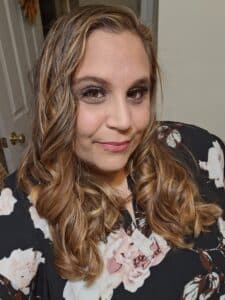
Until next week have a safe and peaceful week!
Facebook: https://www.facebook.com/thenanproject/
Instagram: https://www.instagram.com/the_nan_project/
X (formerly Twitter lol): https://twitter.com/TheNANProject?ref_src=twsrc%5Egoogle%7Ctwcamp%5Eserp%7Ctwgr%5Eauthor
Tik Tok: https://www.tiktok.com/@the_nan_project?lang=en
Blog on website: https://www.thenanproject.org/blog/
Peer Mentor Aiden DeCaro collaborates with Amy Kerr on “I Am More Collection”
We are so excited to share a new piece in Amy Kerr’s “I Am More” collection made in collaboration with our Peer Mentor Aiden!
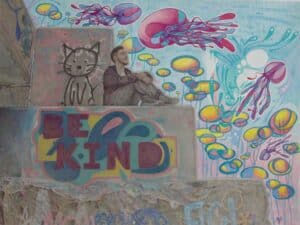
Even though it is not the case now, I am no stranger to feeling less than. A lifetime of dealing with the fallout of mental illness has left me with many moments I’ve felt hollow or broken. Now though, a few years into genuine recovery, I can finally say I know what it’s like to feel whole. It’s been a long journey with a lot of ups and downs that I’m still on today, but I can say with certainty that I have found hope and peace through my symptoms.
TNP Provides New Student Supports
Introduction:
The NAN Project is proud to offer a new program to the community, SEL Circles (Social-Emotional Learning Circles). It is a six-week, in-school, curriculum-based program made for groups of up to 15 students. The program is supported by The NAN Project’s licensed mental health clinician/school counselor, Peer Coordinators, and Peer Mentors.
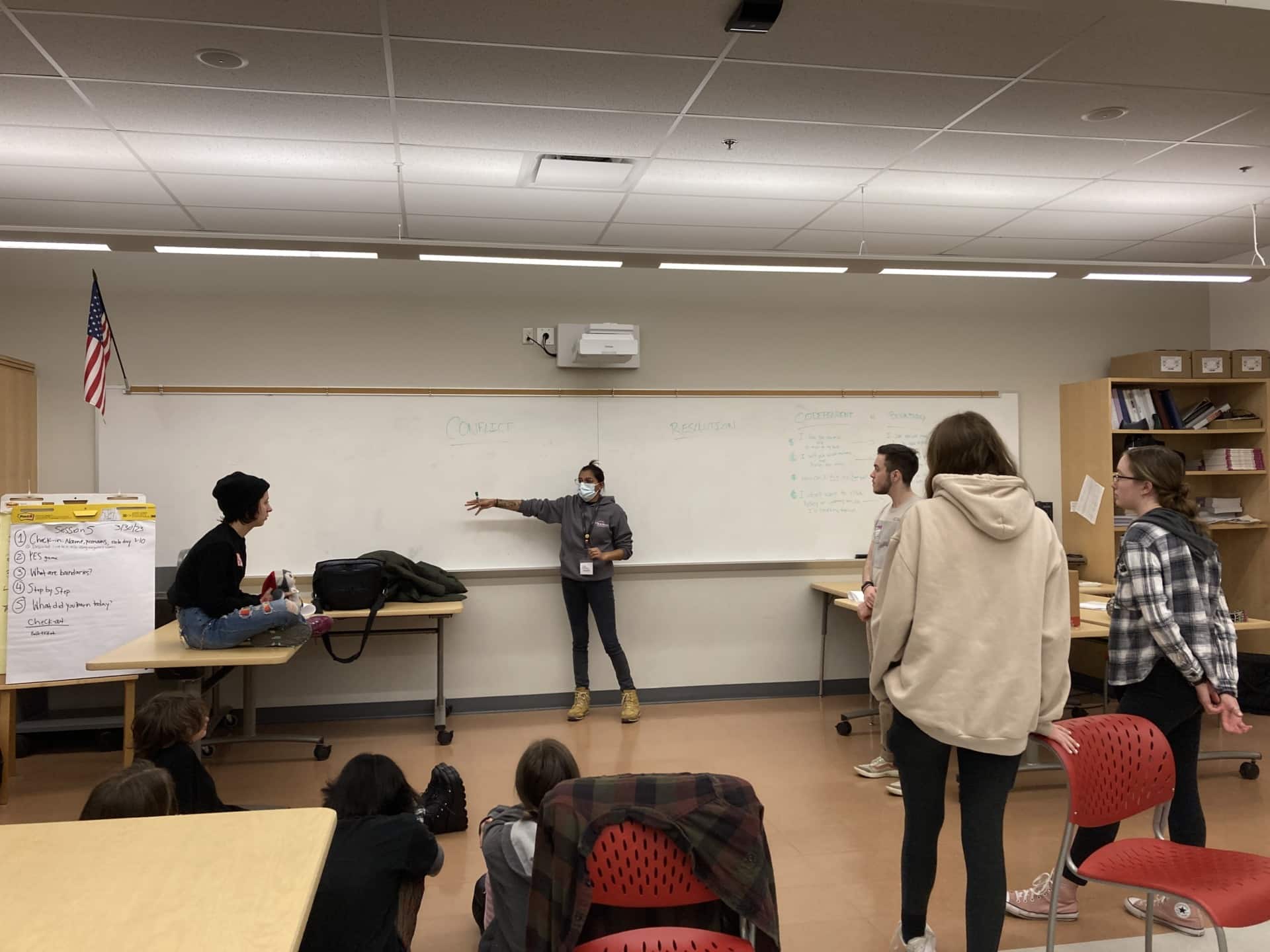
Sarojini Schutt, Peer Coordinator, facilitating a discussion at Galvin Middle School SEL Circles about managing peer conflict
SEL Circles were created due to community providers, educators, and parents noticing changes in the youth they serve–many are more anxious than prior to the pandemic, and have had trouble creating connections with their peers, and looking for programming that could be helpful.
Recent Statistics About Youth Mental Health:
Recent data supports what educators and caregivers have noticed. The CDC’s Youth Risk Behavior Survey collects self-reported surveys from high school students across the United States every two years. The most recent data from 2021 shows that compared to 2019, more high school students are feeling sad or hopeless in a way that impairs their everyday activities (33.8% vs 38.5%), and more students seriously considered attempting suicide (17.5% vs 18.4%). Additionally, out of all US high school students surveyed in 2021, 29.3% reported their mental health was either not good most of the time or not good all of the time, and 38.5% reported they either didn’t feel close to people at their school or weren’t sure.
SEL Circles Curriculum:
SEL Circles are designed to help middle school- and high school-aged youth gain a greater understanding of the warning signs of mental health challenges, the supports that are available to them, ways to help a friend who may be struggling, and coping strategies to deal with their mental health. SEL Circles are not a substitute for or form of therapy. The goal of SEL Circles is to create a safe place where kids can gather and learn new skills related to emotional regulation, active listening, and coping strategies through a trauma-informed lens. By the end of the six week program, youth will have learned more about mental health and how to identify, communicate, and express emotions in a healthy way. The curriculum is offered in a format that is fun, educational, and appealing for students who can benefit from a little extra social-emotional support.
The topics covered in SEL Circles curriculum may include Orientation & Connection, Building Self-Esteem, Managing Reactions to Stress, Mindfulness, Active Listening, Bound
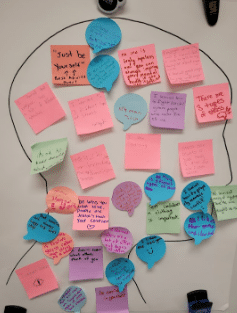
Galvin Middle School students participating in SEL Circles provided colorful feedback.
ary Setting/Managing Peer Conflict, and Reflection & Application. Educators and staff who would like to bring SEL Circles to their school will have the opportunity to discuss the needs of their students with The NAN Project’s School Counselor, Liza Tierney, and tailor the curriculum as needed.
Response From Students:
To date, The NAN Project has facilitated three cohorts of SEL Circles, at the Eliot Family Resource Center in Everett and at Galvin Middle School in Wakefield. The NAN Project staff collected survey data from SEL Circles participants on the first session and on the last session to learn more about what youth are taking away from sessions.
At Galvin Middle School before SEL Circles began, only 50% of the participants self-reported that they knew of coping skills to deal with difficult emotions. On the last day of the program, 80% of students either agreed or strongly agreed that they knew of coping skills to help with difficult emotions. There was also an increase in the pre- and post- survey data regarding the percentage of students who reported they had at least one adult they could speak to about a difficult situation (83% on the first day, compared to 100% on the last day).
When asked what they learned at SEL Circles, students said:
“Conflict doesn’t always have to be negative.”
“I learned good ways to cope with anger and stress”
On the most useful thing youth learned at SEL Circles:
“The 3 Rs [Regulation, Reflection, and Relaxation].”
“How to calm yourself and also that your [sic] not alone.”
“Learning about stress management.”
“That not being OK is OK when you ask for help.”
“I know many things to do when I am sad.”
This spring, The NAN Project is excited to be providing SEL Circles at Thurgood Marshall Middle School in Lynn and Phoenix Academy in Lawrence, in addition to continuing their partnership with Galvin Middle School. To discuss bringing SEL Circles to your school or community, email [email protected].
Our First College Peer Mentor Training & A Peer Mentor Update
Introduction:
Thanks to grant funding from the MA Department of Higher Education, we recently conducted our first college peer mentor training at Massasoit Community College (MCC) in Brockton, MA. This training not only marked a significant milestone for us, but also was a great success. With the collaboration of Violet Akoh, MCC’s Health & Wellness Coordinator, and the leadership of Erica Tangney, TNP’s College Outreach Coordinator, we engaged numerous students through on-campus outreach, ultimately training six new peer mentors. This partnership with Massasoit has opened doors for us to expand our programming into Massachusetts’ Southeast Region.
Successful Peer Mentor Training:
During the training at MCC, our team provided instruction on how to write a Comeback Story, enhance and practice their public speaking skills, and ways to safely speak to youth about mental health. By the end of training, each student had written a powerful story of lived experience. The NAN Project is immensely proud of these peer mentors and all the work they put into the training!
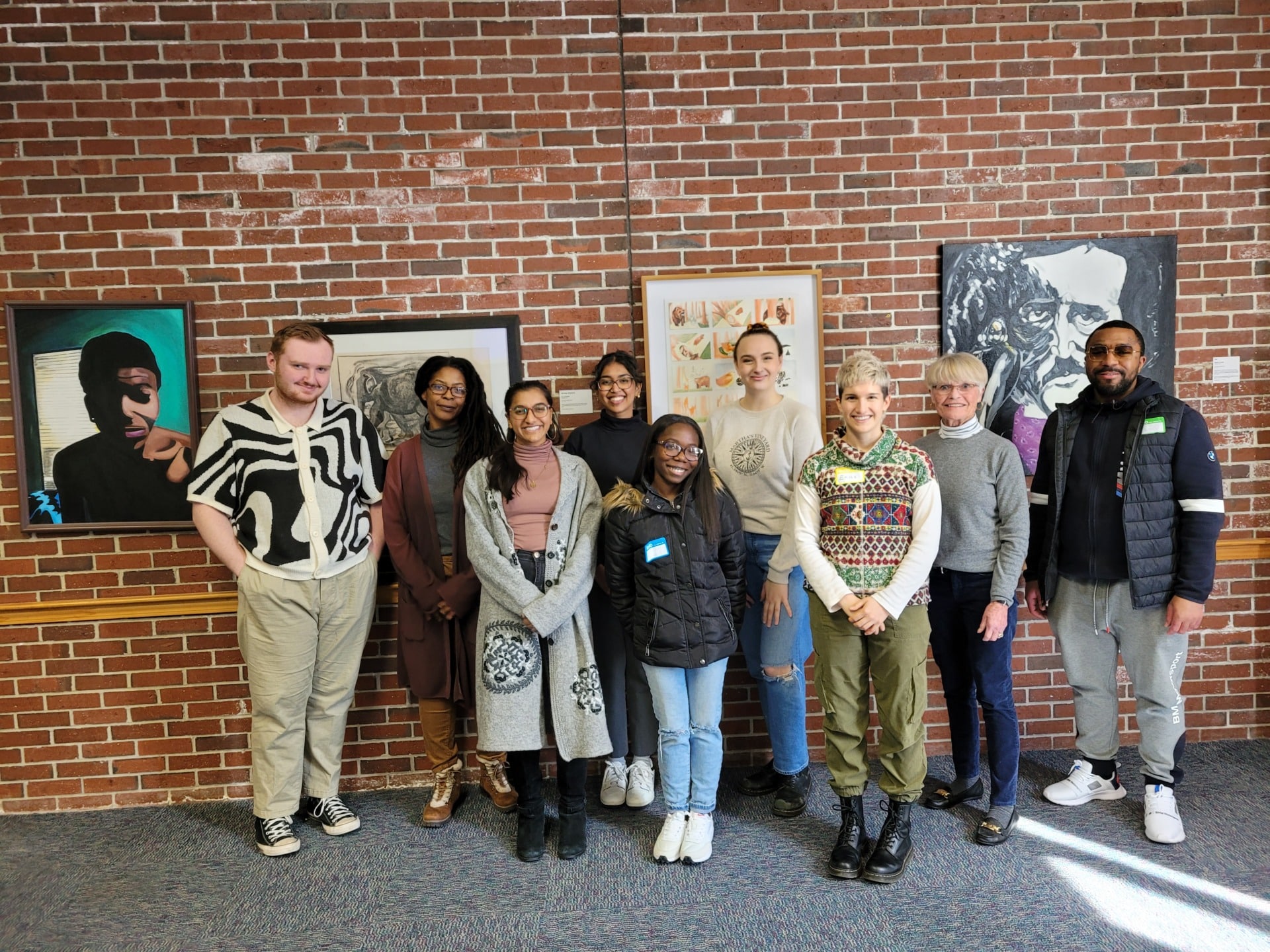
Peer Mentors and TNP Staff at Massasoit CC Training Graduation.
Continued Growth:
Following the training program at Massasoit CC, we have continued efforts to expand our network of peer mentors. An additional four peer mentors have completed our training and have already started attending presentations! We continually hire peer mentors on a rolling basis in order to bring as many presentations to students as possible.
Upcoming Training in Lynn, MA:
As we continue to expand our outreach efforts, we are excited to share that our staff is actively preparing for another training. This time, we will be hosting a training program in Lynn, MA over the summer. We have many community and school partners in the Greater Lynn area. By hiring more peer mentors, we hope to provide more robust programming to Lynn public schools and to strengthen these relationships.
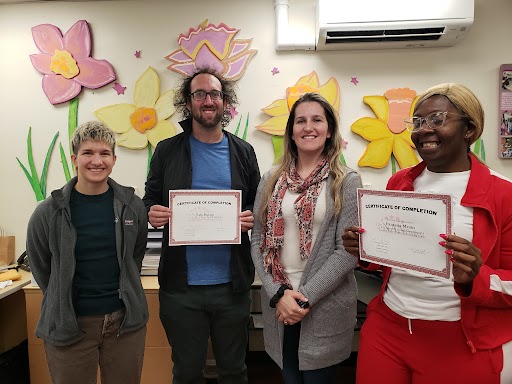
Our Newest Peer Mentor Cohort and TNP Staff.
Final Thoughts:
We are so grateful for MCC and all the peer mentors who work with us. We look forward to holding many more peer mentor training opportunities in the community or in institutions of higher education! For information about our partnerships with colleges and universities, contact Erica at [email protected]. If you are interested in the peer mentor role, please contact Shilpa at sthirukkovalur@thenanproject.











